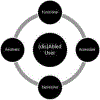Design and development of the first exoskeletal garment to enhance arm mobility for children with movement impairments
- PMID: 28541832
- PMCID: PMC9835012
- DOI: 10.1080/10400435.2017.1320690
Design and development of the first exoskeletal garment to enhance arm mobility for children with movement impairments
Abstract
Children with a variety of diagnoses have impairments that limit their arm function. Despite the fact that arm function is important for early learning and activities of daily living, there are few tools to assist movement for these children, and existing devices have challenges related to cost, accessibility, comfort, and aesthetics. In this article, we describe the design process and development of the first garment-based exoskeleton to assist arm movement in young children with movement impairments: the Playskin LiftTM. We outline our design process, which contrasts with the traditional medical model in that it is interdisciplinary, user-centered, and addresses the broad needs of users, rather than device function alone. Then we report the results of field-testing with the initial prototype with respect to our design metrics on a toddler with significant bilateral arm movement impairments. Finally, we summarize our ongoing development aimed at increasing comfort, aesthetics, and accessibility of the garment. The interdisciplinary, user-centered approach to assistive technology design presented here can result in innovative and impactful design solutions that translate to the real world.
Keywords: assistive technology; design for disability; functional design; open source design; user-centered; wearable technology.
Figures





Similar articles
-
Playskin Lift: Development and Initial Testing of an Exoskeletal Garment to Assist Upper Extremity Mobility and Function.Phys Ther. 2016 Mar;96(3):390-9. doi: 10.2522/ptj.20140540. Epub 2015 Aug 27. Phys Ther. 2016. PMID: 26316534 Free PMC article.
-
Play with objects in children with arthrogryposis: Effects of intervention with the Playskin Lift™ exoskeletal garment.Am J Med Genet C Semin Med Genet. 2019 Sep;181(3):393-403. doi: 10.1002/ajmg.c.31719. Epub 2019 Jun 24. Am J Med Genet C Semin Med Genet. 2019. PMID: 31232529 Free PMC article.
-
Feasibility and Effectiveness of a Novel Exoskeleton for an Infant With Arm Movement Impairments.Pediatr Phys Ther. 2016 fall;28(3):338-46. doi: 10.1097/PEP.0000000000000271. Pediatr Phys Ther. 2016. PMID: 27341584 Free PMC article.
-
Multidisciplinary collaboration on exoskeleton development adopting user-centered design: a systematic integrative review.Disabil Rehabil Assist Technol. 2024 Apr;19(3):909-937. doi: 10.1080/17483107.2022.2134470. Epub 2022 Oct 24. Disabil Rehabil Assist Technol. 2024. PMID: 36278426
-
A review of computer vision for semi-autonomous control of assistive robotic manipulators (ARMs).Disabil Rehabil Assist Technol. 2020 Oct;15(7):731-745. doi: 10.1080/17483107.2019.1615998. Epub 2019 Jul 3. Disabil Rehabil Assist Technol. 2020. PMID: 31268368 Review.
Cited by
-
Current Trends and Challenges in Pediatric Access to Sensorless and Sensor-Based Upper Limb Exoskeletons.Sensors (Basel). 2021 May 20;21(10):3561. doi: 10.3390/s21103561. Sensors (Basel). 2021. PMID: 34065366 Free PMC article. Review.
-
Robotic devices for paediatric rehabilitation: a review of design features.Biomed Eng Online. 2021 Sep 6;20(1):89. doi: 10.1186/s12938-021-00920-5. Biomed Eng Online. 2021. PMID: 34488777 Free PMC article. Review.
-
Wearables for Pediatric Rehabilitation: How to Optimally Design and Use Products to Meet the Needs of Users.Phys Ther. 2019 Jun 1;99(6):647-657. doi: 10.1093/ptj/pzz024. Phys Ther. 2019. PMID: 30810741 Free PMC article.
-
Evaluation of fabric-based pneumatic actuator enclosure and anchoring configurations in a pediatric soft robotic exosuit.Front Robot AI. 2024 Oct 11;11:1302862. doi: 10.3389/frobt.2024.1302862. eCollection 2024. Front Robot AI. 2024. PMID: 39463802 Free PMC article.
-
Design and validation of a smart garment to measure positioning practices of parents with young infants.Infant Behav Dev. 2021 Feb;62:101530. doi: 10.1016/j.infbeh.2021.101530. Epub 2021 Feb 4. Infant Behav Dev. 2021. PMID: 33548894 Free PMC article.
References
-
- Bailes AF, Greve K, Burch CK, Reder R, Lin L, & Huth MM (2011). The effect of suit wear during an intensive therapy program in children with cerebral palsy. Pediatric Physical Therapy: The Official Publication of the Section on Pediatrics of the American Physical Therapy Association, 23(2), 136–142. doi:10.1097/PEP.0b013e318218ef58 - DOI - PubMed
-
- Consumer Product Safety Improvement. (2008). Act, 1 U.S.C. § § 101–104.
-
- Cowan DM, & Khan Y (2005). Assistive technology for children with complex disabilities. Current Paediatrics, 15(3), 207–212. doi:10.1016/j.cupe.2005.02.003 - DOI
Publication types
MeSH terms
Grants and funding
LinkOut - more resources
Full Text Sources
Other Literature Sources
Medical
